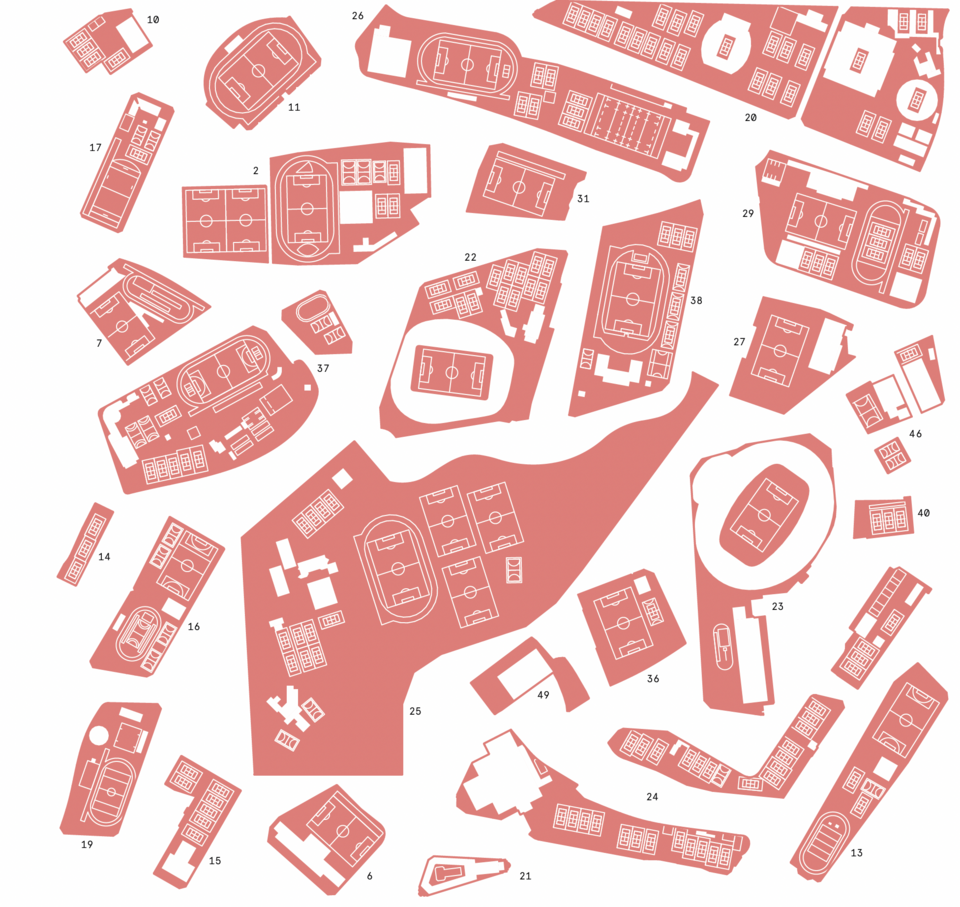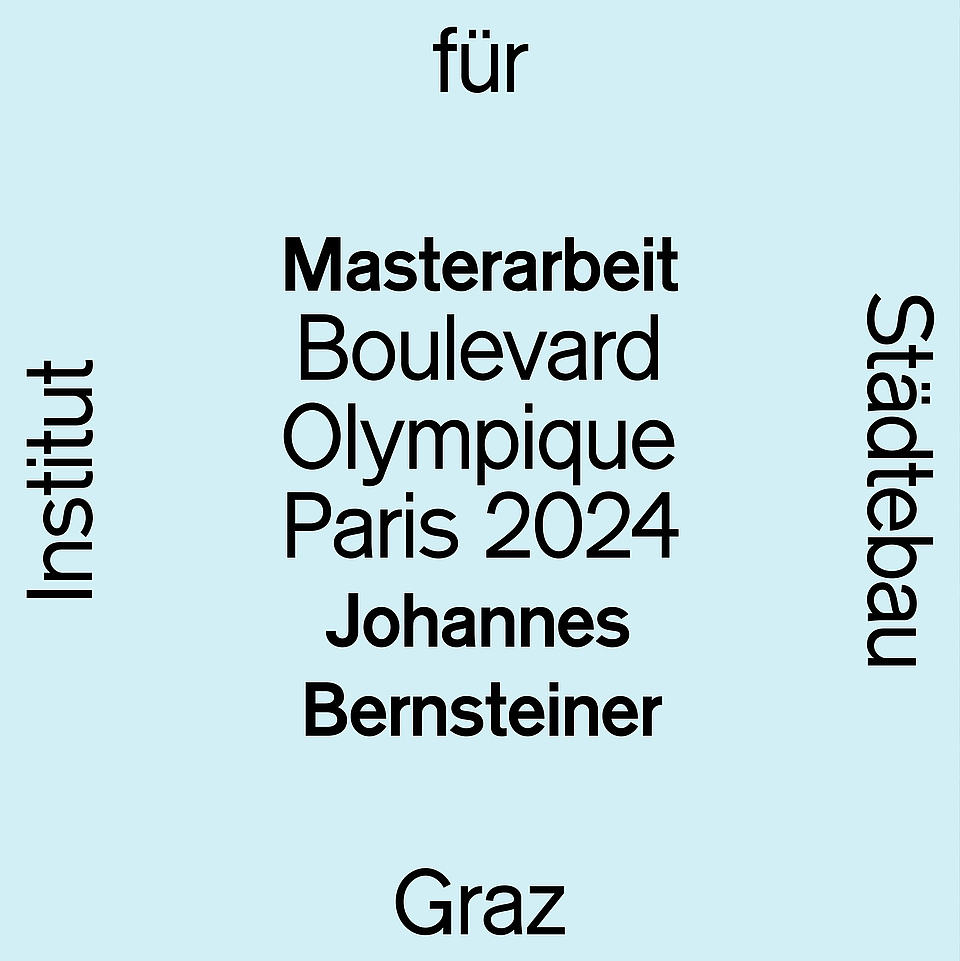Masterthesis Johannes Bernsteiner: Boulevard Olympique - Paris 2024

Boulevard Olympique
Paris 2024
Designing the city today means bringing together existing fragments, some of which are hostile to the daily lives of its inhabitants. Designing the city also means making large infrastructures usable and creating a habitable environment. Ultimately, designing the city means transforming infrastructures into living spaces and creating public spaces, without which urbanity cannot exist. Highways are objects of physical, political, and social significance. They connect and simultaneously fragment territories. They favor certain uses while disadvantaging others. They incentivize or constrain specific modes of transport and serve as critical levers for shaping 21st-century mobility. However, the urban highway is an oxymoron, as the two terms seem fundamentally contradictory. Highways invite us to travel long distances across vast areas, whereas cities tell the story of proximity, building facades, and pedestrians.
The Parisian ring road, or Boulevard Périphérique, epitomized modernity when it was constructed in the 1970s. It represents the peak of the post-war "Trente Glorieuses" and symbolizes a car- and consumption-oriented society that has reached its limits. Today, the "Périph" is synonymous with congestion, and both residents and drivers suffer from its adverse effects. This 35-kilometer-long ring road is a rare example of a motorway encircling the center of a global metropolis. Due to its accessibility and high capacity, it attracts heavy traffic. With 1.1 million vehicles per day, it is the busiest highway in Europe. The air pollution and noise it generates are major public health concerns.
This study offers a fresh perspective on the ring road and urban highways in general, outlining potential redesign measures. To achieve this, we must first acknowledge the spatial presence of large infrastructures and then integrate them into everyday practices.
The challenge lies in articulating a balance between spaces for living and spaces for movement.
If the city can be understood as a palimpsest in which power structures are embedded, what is the significance of its boundaries? The ring road overlaps with Paris's administrative boundary, making it a unique case. Its history is one of division, still bearing the symbolic weight of Paris's last city wall. It creates a clear distinction between an "inside" and an "outside," reflecting a socially charged hierarchy. This relationship of dominance vividly illustrates the spatial and organizational dynamics of capitalism at the metropolitan scale. This study does not seek to deny this reality but instead reimagines the boundary as a "site of possibilities." The ring road thus becomes a remarkable testing ground for envisioning a new metropolitan future.
The aim is to move beyond the automobile-centric fascination with infrastructure and envision a more harmonious version—a part of the city where seemingly incompatible elements complement each other.
The removal of this boundary is central to the ongoing debate in the Paris metropolitan region, navigating between competitiveness and solidarity, dynamism and urbanity, progress and the need for nature. Today, this road infrastructure seems to stand in the way of the ambitions of Grand Paris, which now acknowledges that its future lies beyond Paris's historic city walls. This shift in scale necessitates transcending the ring road and integrating it into both urban and metropolitan contexts. The ring road must therefore be reimagined to dismantle the symbolic barrier between Paris and its suburbs. Its territorial space, seen from this perspective, becomes a new "promised land" for a metropolis that overcomes existing boundaries to reconcile the capital with its suburbs, improve the daily lives of its residents, and secure its position in the global hierarchy of cities.
Current efforts to mitigate the ring road's impact include increasing cross-connections, reducing speed limits, and building green overpasses, but a true vision matching the ambitions of the Ville Lumière is still sorely lacking.
Haussmann transformed boulevards into the heart of the capital. Paul Delouvrier attempted to create new centers in the suburbs with the Villes Nouvelles. The Olympic Boulevard pursues a similarly ambitious goal: to become the new center of the Grand Paris metropolis. Research into its integration into the urban context questions the possibility of intervening directly in the ring road, redefining or adapting it. Urban integration of the ring road necessarily requires its structural complexity to increase, moving beyond its singular function of facilitating car movement. The Olympic Boulevard aims to transform the physical and symbolic disturbances of this boundary line into a major urban catalyst at the heart of the Grand Paris metropolis. Paris's former city gates will become major squares of Grand Paris, giving the ring road new meaning as a metropolitan center.
This project demonstrates that infrastructures, particularly highways and expressways, can become the great public spaces of tomorrow. The transformation of the ring road involves restricting car traffic by dedicating lanes to public transport and carpooling, adding generous cycling paths, and creating new green spaces. These measures will calm the traffic axis and enhance cross-connections. The Olympic Boulevard will thus become a multimodal infrastructure.
Today, sport plays a relatively minor role in the consciousness of the Grand Paris metropolis. The 2024 Olympic Games offer a unique opportunity to implement a new sports policy at the metropolitan level. From this perspective, the Olympic Boulevard will serve as a large open-air sports facility. Currently, almost 80% of Paris's sports facilities are located near this infrastructure. The Olympic Boulevard also connects most of the competition and training venues for the Olympic Games, a fact that inspired its new name. The Olympic Boulevard thus aims to explore the uncharted future of hybridizing sport and mobility in the city.
